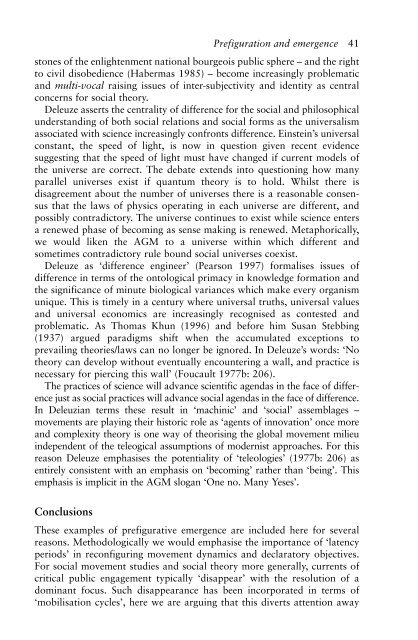Complexity and Social Movements: Multitudes at the Edge of Chaos ...
Complexity and Social Movements: Multitudes at the Edge of Chaos ...
Complexity and Social Movements: Multitudes at the Edge of Chaos ...
You also want an ePaper? Increase the reach of your titles
YUMPU automatically turns print PDFs into web optimized ePapers that Google loves.
stones <strong>of</strong> <strong>the</strong> enlightenment n<strong>at</strong>ional bourgeois public sphere – <strong>and</strong> <strong>the</strong> right<br />
to civil disobedience (Habermas 1985) – become increasingly problem<strong>at</strong>ic<br />
<strong>and</strong> multi-vocal raising issues <strong>of</strong> inter-subjectivity <strong>and</strong> identity as central<br />
concerns for social <strong>the</strong>ory.<br />
Deleuze asserts <strong>the</strong> centrality <strong>of</strong> difference for <strong>the</strong> social <strong>and</strong> philosophical<br />
underst<strong>and</strong>ing <strong>of</strong> both social rel<strong>at</strong>ions <strong>and</strong> social forms as <strong>the</strong> universalism<br />
associ<strong>at</strong>ed with science increasingly confronts difference. Einstein’s universal<br />
constant, <strong>the</strong> speed <strong>of</strong> light, is now in question given recent evidence<br />
suggesting th<strong>at</strong> <strong>the</strong> speed <strong>of</strong> light must have changed if current models <strong>of</strong><br />
<strong>the</strong> universe are correct. The deb<strong>at</strong>e extends into questioning how many<br />
parallel universes exist if quantum <strong>the</strong>ory is to hold. Whilst <strong>the</strong>re is<br />
disagreement about <strong>the</strong> number <strong>of</strong> universes <strong>the</strong>re is a reasonable consensus<br />
th<strong>at</strong> <strong>the</strong> laws <strong>of</strong> physics oper<strong>at</strong>ing in each universe are different, <strong>and</strong><br />
possibly contradictory. The universe continues to exist while science enters<br />
a renewed phase <strong>of</strong> becoming as sense making is renewed. Metaphorically,<br />
we would liken <strong>the</strong> AGM to a universe within which different <strong>and</strong><br />
sometimes contradictory rule bound social universes coexist.<br />
Deleuze as ‘difference engineer’ (Pearson 1997) formalises issues <strong>of</strong><br />
difference in terms <strong>of</strong> <strong>the</strong> ontological primacy in knowledge form<strong>at</strong>ion <strong>and</strong><br />
<strong>the</strong> significance <strong>of</strong> minute biological variances which make every organism<br />
unique. This is timely in a century where universal truths, universal values<br />
<strong>and</strong> universal economics are increasingly recognised as contested <strong>and</strong><br />
problem<strong>at</strong>ic. As Thomas Khun (1996) <strong>and</strong> before him Susan Stebbing<br />
(1937) argued paradigms shift when <strong>the</strong> accumul<strong>at</strong>ed exceptions to<br />
prevailing <strong>the</strong>ories/laws can no longer be ignored. In Deleuze’s words: ‘No<br />
<strong>the</strong>ory can develop without eventually encountering a wall, <strong>and</strong> practice is<br />
necessary for piercing this wall’ (Foucault 1977b: 206).<br />
The practices <strong>of</strong> science will advance scientific agendas in <strong>the</strong> face <strong>of</strong> difference<br />
just as social practices will advance social agendas in <strong>the</strong> face <strong>of</strong> difference.<br />
In Deleuzian terms <strong>the</strong>se result in ‘machinic’ <strong>and</strong> ‘social’ assemblages –<br />
movements are playing <strong>the</strong>ir historic role as ‘agents <strong>of</strong> innov<strong>at</strong>ion’ once more<br />
<strong>and</strong> complexity <strong>the</strong>ory is one way <strong>of</strong> <strong>the</strong>orising <strong>the</strong> global movement milieu<br />
independent <strong>of</strong> <strong>the</strong> teleogical assumptions <strong>of</strong> modernist approaches. For this<br />
reason Deleuze emphasises <strong>the</strong> potentiality <strong>of</strong> ‘teleologies’ (1977b: 206) as<br />
entirely consistent with an emphasis on ‘becoming’ r<strong>at</strong>her than ‘being’. This<br />
emphasis is implicit in <strong>the</strong> AGM slogan ‘One no. Many Yeses’.<br />
Conclusions<br />
Prefigur<strong>at</strong>ion <strong>and</strong> emergence 41<br />
These examples <strong>of</strong> prefigur<strong>at</strong>ive emergence are included here for several<br />
reasons. Methodologically we would emphasise <strong>the</strong> importance <strong>of</strong> ‘l<strong>at</strong>ency<br />
periods’ in reconfiguring movement dynamics <strong>and</strong> declar<strong>at</strong>ory objectives.<br />
For social movement studies <strong>and</strong> social <strong>the</strong>ory more generally, currents <strong>of</strong><br />
critical public engagement typically ‘disappear’ with <strong>the</strong> resolution <strong>of</strong> a<br />
dominant focus. Such disappearance has been incorpor<strong>at</strong>ed in terms <strong>of</strong><br />
‘mobilis<strong>at</strong>ion cycles’, here we are arguing th<strong>at</strong> this diverts <strong>at</strong>tention away




